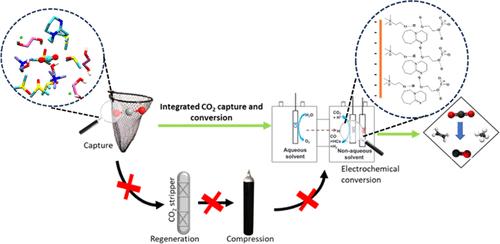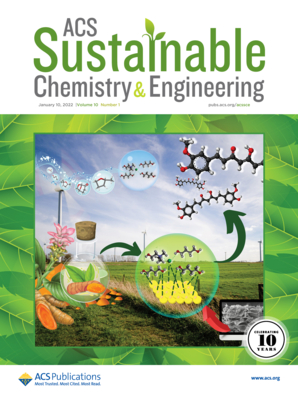调节深共晶溶剂型定制电解质块体和电化学界面中的分子相互作用,促进反应性二氧化碳捕获
IF 7.1
1区 化学
Q1 CHEMISTRY, MULTIDISCIPLINARY
引用次数: 0
摘要
传统的二氧化碳捕获和利用(CCU)使用胺水溶液,但其对环境的不利影响和再生二氧化碳的高能耗过程是实现可持续发展的主要障碍。作为替代方案,电化学反应式二氧化碳捕集(eRCC)将二氧化碳捕集与转化融为一体,被认为是一种经济、可持续的二氧化碳增值方法。然而,设计一个具有定制电化学界面的合适电解质系统以实现高效的 eRCC 是一项重大挑战。在此,我们报告了一种基于深共晶溶剂(DES)的定制电解质,它含有一种超碱基(DBU:1,8-二氮杂双环[5.4.0]十一碳-7-烯)、一种非烷基稀释剂(DMSO:二甲亚砜)和乙碱(Eth),可用于高效、低成本的 eRCC。与原始乙醇相比,定制的 DES 电解质的 eRCC 性能提高了数倍,具有良好的二氧化碳捕获能力,在高温(即 50 °C)条件下转化率更高(363.6 μmol cm-2 h-1)。光谱、电化学和理论(AIMD)研究表明,DES 与 CO2 之间的调制分子相互作用促进了对 CO2 的捕获,并有助于释放捕获的 CO2 以进行后续还原。总之,由于在定制的 DES 中形成了紧凑的电双层,因此质量传输方便,电极表面的二氧化碳浓度更高,中间产物更加稳定,从而实现了相对较高的 eRCC 性能。本文章由计算机程序翻译,如有差异,请以英文原文为准。

Modulating Molecular Interactions in Bulk and Electrochemical Interfaces of Deep Eutectic Solvent-Based Tailored Electrolytes for Facilitating Reactive CO2 Capture
The conventional CO2 capture and utilization (CCU) uses aqueous amine solutions, but its environmental hostility and energy-intensive process to regenerate CO2 are major hurdles toward sustainability. Alternatively, electrochemical reactive CO2 capture (eRCC) that integrates CO2 capture and its conversion has been considered a promising method for economical and sustainable CO2 valorization. However, designing a suitable electrolyte system with tailored electrochemical interfaces for efficient eRCC is a major challenge. Herein, we report a tailored deep eutectic solvent (DES)-based electrolyte containing a superbase (DBU: 1,8-diazabicyclo[5.4.0]undec-7-ene), an aprotic diluent (DMSO: dimethyl sulfoxide), and ethaline (Eth) for an efficient and low-cost eRCC. The tailored DES electrolyte depicts multifold improvement in eRCC performance compared to pristine Eth with good CO2 capture capacity and a superior conversion rate (363.6 μmol cm–2 h–1) at elevated temperatures (i.e., 50 °C). The spectroscopic, electrochemical, and theoretical (AIMD) investigations suggest that the modulated molecular interactions between DES and CO2 boost its capture and facilitate the release of captured CO2 for subsequent reduction. Overall, the facile mass transport, higher concentration of CO2 at the electrode surface, and greater stabilization of intermediates due to the formation of a compact electrical double layer in a tailored DES resulted in relatively high eRCC performance.
求助全文
通过发布文献求助,成功后即可免费获取论文全文。
去求助
来源期刊

ACS Sustainable Chemistry & Engineering
CHEMISTRY, MULTIDISCIPLINARY-ENGINEERING, CHEMICAL
CiteScore
13.80
自引率
4.80%
发文量
1470
审稿时长
1.7 months
期刊介绍:
ACS Sustainable Chemistry & Engineering is a prestigious weekly peer-reviewed scientific journal published by the American Chemical Society. Dedicated to advancing the principles of green chemistry and green engineering, it covers a wide array of research topics including green chemistry, green engineering, biomass, alternative energy, and life cycle assessment.
The journal welcomes submissions in various formats, including Letters, Articles, Features, and Perspectives (Reviews), that address the challenges of sustainability in the chemical enterprise and contribute to the advancement of sustainable practices. Join us in shaping the future of sustainable chemistry and engineering.
 求助内容:
求助内容: 应助结果提醒方式:
应助结果提醒方式:


